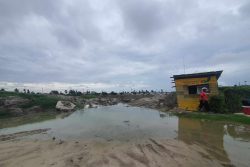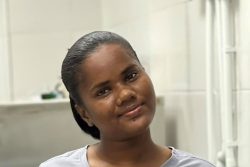Dear Editor,
I refer to the editorial in yesterday’s Kaieteur News entitled `A fishy budget proposal.’
Seventy percent of the planet Earth’s surface is water. As the world progressed into the realm of ‘farming the ocean’ it had been waiting for something important to happen technically to start the process, this happened about 10-15 years ago with the invention of a material called High Density Polyethylene, HDPE. When 8 to 10-inch diameter pipes made from this material are used to form a floating cage it can withstand not only the normal wave action in the ocean, but even the much higher wave action during a typhoon! They could last upwards of 20-25 years, unlike the wooden cages which only lasted five years.
Since the 1990s, wild catch worldwide has remained steady at US$90 billion per year, whilst aquaculture has been rising to handle the growing protein requirement of the ever increasing global population. Four or five years ago the fish and other products, grown from aquaculture surpassed the income of wild catch worldwide.
I noted the KN article is alleging that “Government is pumping $200 million into an unproven fish cage initiative”. In a 67-page technical paper on page number 498 published by the FAO we see the following, “Cage aquaculture has grown rapidly during the past decades and is undergoing swift changes due to pressures from globalisation and an escalating demand worldwide for fish products”. If such a statement from the Food and Agricultural Organization of the United Nations is true, the claim by the KN that cage culture is a ”fishy unproven technology” cannot also possibly be true.
The KN also wrongly states elsewhere that aquaculture in ponds is proven technology but not cage culture.
The benefits of cage culture over open pond culture are as follows, aquaculture is the fastest growing industry in agriculture worldwide, what is less commonly understood is that the farming of the oceans, lakes and rivers is contributing significantly to its great expansion.
The reasons are numerous and can be summed up as follows 1. It is cheaper 2. It is less damaging to the environment if done properly. Aquaculture ponds must be dug and graded. This requires heavy expensive equipment, diesel, operators etc. 3. Electricity has to be used to pump water to and from the ponds 4. Electricity must also be used to create aeration in the ponds and aerators must be bought for this purpose 5. Pollution [metabolic waste] has to be removed from the aquaculture ponds after two or three crops since it can end up as environmental damage.
Cage culture only requires the cage, and the feed, there is no digging to be done, no formal and expensive structures are required to bring in or take out the water, there is no metabolic waste to clean, since the ocean tide and river flow is removing it for free, harvesting and feeding are confined to an area of a few hundred square feet. Less feed is required in this type of semi-intensive to intensive culture since the feed provided by the farmer is being supplemented by organisms from the river, lake or sea. There are no electrical costs to stir and recirculate water since the water is quite literally being refreshed with oxygen from the tidal/river flow. These being the facts we visualize that in the interior regions our remote Amerindian villages, always close to the flowing rivers, could benefit much more readily than pond-based aquaculture. River cages are considerably less expensive than ocean cages, due to the lack of heavy wave action.
So it is applicable everywhere in a land like Guyana, where fast flowing rivers abound due to our high rainfall and fast flowing ocean currents in the nearly 285 Kilometers of coast land facing the Atlantic.
The cons are few 1. You have to buy or build the cages, but with the arrival of HDPE the cost is vastly reduced and the reliability greatly improved. 2. Security. We are proposing that the fishermen form alliances with the farmers to man these cages backed up by surveillance by drones. The cages will only be located a short distance from the shoreline – one to five miles. Since the cages can be set up in the ocean in groups there will be several cages in one location facilitating better security. This system can be easily equipped with solar-powered lights to alert shipping of their existence to avoid collision. And since they are so close to the shore very large vessels will have run aground long before they can collide with these cages.
Farming the oceans is becoming mainstream practice worldwide and for Guyana the main problems we visualize due to the feasibility studies we have conducted so far, to make us an economical worldwide competitor, is the lack of a salt water hatchery which we will certainly have to build, since the Satyadeow Sawh hatchery at Mon Repos does not have ready access to salt water to breed the necessary stocking species both fish and shrimp which the President’s Aquaculture plans visualize. We will also have to manufacture our own fish/shrimp feed for the various types of aquaculture species which we will need. As far as competition for markets in America, we are much closer to the US than say China which gives us a very large advantage.
Yours faithfully,
Anthony Vieira,
National Aquaculture Coordinator






